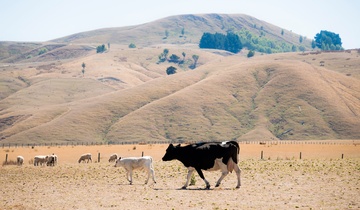For 27 October 2016
A weekly update describing soil moisture across the country to help assess whether severely to extremely dry conditions are occurring or imminent. Regions experiencing these soil moisture deficits are deemed “hotspots”. Persistent hotspot regions have the potential to develop into drought.
Facts: soil moisture
Across the North Island, soil moisture levels have generally not changed significantly since this time last week. Slight decreases were observed in Northland, northern Waikato, northern Manawatu-Wanganui, and eastern Bay of Plenty. Meanwhile, soil moisture levels have increased in southern Taranaki, Wellington to interior Wairarapa, and coastal Hawke’s Bay and Gisborne. The driest North Island soils compared to normal for this time of the year are still found in coastal Wairarapa, while the wettest are found in northern Hawke’s Bay and southern Gisborne.
Across the South Island, soil moisture levels have generally increased in the north and east since this time last week, while slight decreases occurred in southwestern Southland. The driest South Island soils compared to normal for this time of the year are found in northern Canterbury, while the wettest are found in Nelson, eastern Tasman, and western Marlborough.
Outlook and soil moisture
For the North Island, a front will bring light rain to most locations on Saturday (29th October), with additional light showers on Sunday. While most places will see 10 mm or less this weekend, up to 15 mm is possible in Auckland and southern Northland. Monday and Tuesday will be mostly dry, with any isolated showers producing only minimal rainfall. Another front moving through on Tuesday night and Wednesday will produce a fairly uniform 10-15 mm across the North Island.
While official hotspot areas are unlikely to develop across the North Island during the next week, the dry coastal Wairarapa region will likely see conditions get worse as total rainfall will not be enough to provide improvement. The remainder of the North Island will likely see soils become slightly drier over the next week as well.
For the South Island, a front moving north on Friday (28th October) will bring heavy rain to Fiordland and the West Coast, with widespread amounts of 50-75 mm and isolated totals up to 100 mm. Meanwhile, 15-25 mm will fall across eastern Southland, interior Otago, and much of Canterbury, with only light rainfall in the northern South Island. An additional 5-10 mm may fall in eastern and northern areas during the weekend. Another front arriving on Tuesday (1st November) will produce 10-20 mm of rain for the western and northern South Island, but only minimal rain for eastern areas.
Official hotspots are unlikely to develop in the South Island during the next week, but little if any additional improvement is expected to soil moisture levels in central and northern Canterbury. Drier soils may once again occur in eastern Marlborough in the next week due to low rainfall amounts. However, improvement is likely in southwestern Southland due to substantial rainfall there.
Background
Hotspot Watch: a weekly advisory service for New Zealand media. It provides soil moisture and precipitation measurements around the country to help assess whether extremely dry conditions are imminent.
Soil moisture deficit: the amount of water needed to bring the soil moisture content back to field capacity, which is the maximum amount of water the soil can hold.
Soil moisture anomaly: the difference between the historical normal soil moisture deficit (or surplus) for a given time of year and actual soil moisture deficits.
Definitions: “Extremely” and “severely” dry soils are based on a combination of the current soil moisture status and the difference from normal soil moisture (see soil moisture maps)






